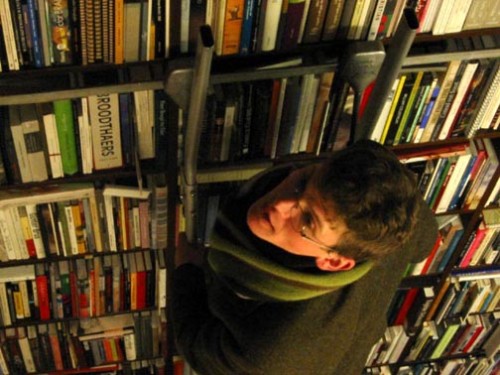This month, I had the pleasure of speaking with a former colleague, Anthony Elms, who recently joined the Institute of Contemporary Art, Philadelphia as Associate Curator. Anthony, more than anyone I know, is always looking, reading and listening, and is interested in a wide range of topics and genres. His first exhibition at the ICA will open February 1, 2013. The concept of the exhibition is still developing, but his thoughts begin with a quote from JG Ballard that has stayed with him for over ten years: “Fashion: A recognition that nature has endowed us with one skin too few, and that a fully sentient being should wear its nervous system externally.” The interest lies in fashion as much as it does in the pose—how does one reveal or project an idea of self into the world? Anthony’s approach is nuanced. He refers to a quote from Wayne Koestenbaum’s foreword for Roland Barthes’ The Lover’s Discourse: “Banish the message. Preserve the exaltation that surrounds it. Investigate the perfume that the message leaves behind.” Anthony describes his thoughts around the quote as follows:
That is a quality I keep coming back to. You might have a message, you might have a thought, but what is the perfume in the air with what you do? I am looking at artwork that is really good at capturing the perfume around however you’ve posed yourself, so you can actually see the pose as opposed to where the pose might be coming from. It’s a slippery thought, but I think I am getting close.
The following is a list of texts that have been floating around Anthony’s head, “possibly in order of importance,” as he prepares for his upcoming show at the ICA:
Marcel Proust, The Guermantes Way (1920/1921)
Hilton Als, The Women (1996)
Merlin Carpenter, “Fashion is Fun: An interview with Stefano Pilati by Merlin Carpenter,” Texte zur Kunst Vol. 20 No. 78 (2010)
Diedrich Diederichsen, “Radicalism as Ego Ideal: Oedipus and Narcissus,” e-flux (2011)
Wayne Koestenbaum, “Foreword: In Defense of Nuance” from Roland Barthes’ The Lover’s Discourse (1978)
Kelly Huang: You mentioned to me previously that Proust’s The Guermantes Way is the most important of the texts provided. How has this text proved most influential?
Anthony Elms: Probably two-thirds of that book is made up of gossipy dinner conversation—complaining about who’s not at the table, or who could be at the table, or even the people who are at the table or dismissing people for how they are dressed at the table. I was stunned at how much can happen in just those quick glances that we discard. And I can’t think of a better way that that happens than in fashion. I can’t think of a better way that that happens than in clothing. In the Proust, there is a brief little description when the narrator says,
Ahead of me there was simply a gentleman in evening dress walking away from me; but around him, as if I were playing with a clumsy reflector which I was unable to focus accurately upon him, I projected the idea that he was the Prince de Saxe on his way to join the Duchesse de Guermantes. And although he was alone, this idea, external to him, impalpable, immense, and as unsteady as a searchlight, seemed to go before him as a guide, like the deity who stands beside Greek warriors in battle but is invisible to others.
What I like about that quote is that the narrator is saying there is this look that made him think this person was someone he wasn’t, based on how they were dressed, and he had written this whole narrative of this person that had nothing to do with who the person was. I am fascinated by that and fascinated by maybe trying to suspend the negative judgment that would fall on one or the other side of the equation and want to find a show that floats in that space of that misrecognition. That misrecognition does not have to be bad. What happens in that moment that you have decided that the dress fixes the person, but before you have yet judged them?
KH: In “Radicalism as Ego Ideal: Oedipus and Narcissus,” Diedrich Diederichsen discusses Narcissism as the driving force for the younger generation of artists today in contrast to radicalism, which defined the generation before them. This idea has to do with the artist positioning him or herself to meet a self-proscribed ideal rather than trying to break from those that came before. How do you think this Narcissism plays out in how artists are working today?
AE: Part of me is stubborn and whenever I sense that one thing is taking hold, I want to react against it. One of the ways I decided that this was a show I wanted to do was that I started to see how people were talking about archives. And we look at the art world of the last 10 years, and how important archives, rediscovery of things, reworking histories, working on a new version of a history—it might be discussed as political, it might be discussed as exploratory, it might be discussed as social—ultimately, it is all about looking at ourselves and deciding what we look like. I wanted to deal with the action behind looking at archives, which is sort of like staring at yourself in the mirror. That got me started thinking about Narcissus with a capital “N.” When Narcissus is looking at his reflection in the mirror, he is not seeing himself—there is a time lag there. He constantly looks, trying to catch himself as he looks, but he never quite gets there. That seemed very appealing. And then, that nicely connected together with a couple of things. When I started thinking of Occupy and these protests where earnestness has become more important and more of a topic, the more and more people talk about it, the more and more they are projecting out against who is not doing it properly, who is not involved enough. There is definitely a sense that you are or are not positioned. Part of me started thinking, well, you never recognize your own style but you are fascinated by it intently. You are only recognizing the distance between the style of others and your own. Maybe there is a reason to look at how we clothe ourselves and position ourselves to be more aware of the poses we are taking with the voice that we assume. Diederichsen is always an essayist that I go to and that essay made me realize that yes, this is what I want to do. I’ve got a hunch and now I know I want to do it.
KH: I found the Hilton Als hard to categorize as any one type of book or approach. But, it was a memoir in the way he was telling his story through these other people and how his identity was built through these characters he either knew personally or through pop culture. It all reflects back to the self.
AE: I have always taught that book in a class called Art Theory and Practice. For me, if you think of art, theory and practice as three things and you try to put those three things together in equal weight, there are very few examples that are as beautiful as that Hilton Als book: you can be both artful and theoretical and actually practice both at the same time. And not just in the fact that he is a good writer and is able to use his own life reflexively and then try to craft it into something you experience. Every time I read it (I read it at least three times a year), a different phrase sticks out in my head. Recently, I have been obsessed with how in the first few pages, when he is describing his mother and leading up to describing her as a “Negress,” he pretty much always describes her negatively—what she doesn’t do, what she refuses to do. There is a defining through refusal, which is what we normally would say is avoiding the situation, but after six pages you realize through her refusal to give into these things, he is marking the map at which she refuses to let the world’s problems meet her, and prioritize her own problems or her own thoughts or her own space. The fact that he defines her as a refusal actually makes more sense than telling us anything directly about her. The quality of that book is what I would like. I would like a show that might deflect direct thoughts of what it is about, but it might tell you a lot about itself by how it just stands there.
KH: The Merlin Carpenter interview with Stefano Pilati of Yves Saint Laurent (YSL) was a surprising read for me. I have never heard fashion or the creative process behind creating fashion so eloquently described and dissected. Pilati talks in depth about his struggles to carry forward the ideas and history of YSL while also moving the brand forward and inserting his own artistic vision. At one point he says, “There is no evolution, if there is not a previous method that has been integrated.” The process he describes is similar to the ideas discussed in Diederichsen’s essay. What parallels do you see between the process Pilati describes and the process that contemporary artists go through?
AE: For me, writing has never been privileged over looking; for me it is about trying to marry the two. There are things that you see in the world that you can’t stop reading around and there are the things that you read that you can’t stop seeing about. Hopefully, you slow down enough to figure out how the two are entwined without forcing them. I have quoted this interview in essays about painting. He is actually talking very concretely about how you just forget what you know and try to fill the frame properly. A stretcher is a very limiting structure, and the human body is a very limiting structure. I really like that in the interview, he keeps coming back to this notion of references and how you get past the references to actually forget where they come from and just collage them together.
KH: He says, “references come to your mind as fast as ideas and when you start to analyze your ideas, because you are obviously connected to it, you start to analyze it not because you want to be conceptual or intellectual necessarily, especially not in a domain like fashion, but because you want to see if it might make sense or not.” That really stood out to me.
AE: I copied that quote out verbatim into a notebook when I first read it and was like, oh yeah, save that one. This interview is about clothing, and it does sum up the ways fashion will cycle through looks and things will change, and it is not a narrative you can write out, but it is a narrative that you can feel. And is that so different from why we make art? It totally hits on a nail that you might not reference something because you want someone to recognize it, but you have to start from somewhere. You need to cycle through and just live the references that make you you, and you might not always be able to put them together into something new. For example: archives and Narcissus. If Diederechsen gives me the political pull that I want for the show, and Hilton Als gives me the emotional pull that I want for the show, this interview reminds me materially how to tread between both of those poles.





